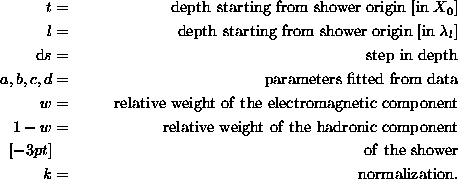Secondaries are mostly pions and nucleons. The hadronic multiplication process is measured at the scale of nuclear interaction length ![]() , which is essentially energy-independent.
, which is essentially energy-independent.
Intrinsic limits on the energy resolution of hadronic calorimeters are:
| backscattering and other albedo processes, |
|
leakage due to |
| nuclear excitation, nuclear breakup, nuclear evaporation. |
The average ratio between signals from electromagnetic and hadronic particles of the same incident energy is calorimeter- and energy-dependent; for a non-compensating calorimeter, one has typically
![]()
For possible improvements,
![]() Compensating Calorimeter.
Compensating Calorimeter.
At high energies some characteristic numbers of hadronic showers can be described by a simple parameterization in terms of ![]() (see [Fabjan82]:
(see [Fabjan82]:
shower maximum:
![]()
shower depth for 95% longitudinal containment:
![]()
shower radius for 95% radial containment:
![]()
Lengths are measured from the calorimeter face. For the average differential energy deposit over the volume of the cascade an acceptable longitudinal parametric approximation is given in [Bock81]:
![]()
with

A simple formula for the average lateral hadronic shower development is not in common use; double exponentials or combinations of exponentials with Gaussian curves have been applied with success (see [Acosto92]); superposition of two Breit-Wigner distributions has also been experimented with ([Durston93]).
Average energy depositions allow one, in principle, to give an (average) energy density in three dimensions, which can be mapped onto any calorimeter cell structure; fluctuations can be added, but are a poor approximation to the reality of showers. A more realistic parameterization of shower fluctuations has been proposed by [Iaselli92]; in that model, the mean ![]() and standard deviation
and standard deviation ![]() , and their correlations,
are parameterized for the energy in each layer of a sampling calorimeter. While this results in realistic showers,
the method is applicable only for a specific calorimeter, and requires substantial preprocessing of fully simulated (or measured) showers.
, and their correlations,
are parameterized for the energy in each layer of a sampling calorimeter. While this results in realistic showers,
the method is applicable only for a specific calorimeter, and requires substantial preprocessing of fully simulated (or measured) showers.
Contrary to electromagnetic showers, which develop in subnanosecond time, the physics of hadronic showers is characterized by different time scales, the slowest of which (de-excitation of heavy nuclei) may reach a microsecond (see [Caldwell93]).